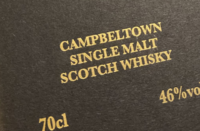Campbeltown Whisky

Campbeltown Whisky
The world of Scotch whisky is divided into five regions, each with its own unique characteristics and flavors. One of these regions, Campbeltown, may be small in size, but it is grand in character and history. Located on the west coast of Scotland's Kintyre Peninsula, Campbeltown is renowned for its robust and complex whiskies that leave a lasting impression on both the nose and the palate. This blog delves deep into the rich tradition and unique features of the Campbeltown whisky region.
History of Campbeltown Whisky
Campbeltown has a rich history dating back to the early 19th century. Once considered the "whisky capital of the world," this region boasted more than 30 distilleries at its peak. The combination of a favorable geographical location for importing barley and peat, along with an excellent water source, made Campbeltown ideal for whisky production.
During its heyday, Campbeltown produced whiskies that were beloved worldwide for their unique and powerful flavor profiles. However, at the beginning of the 20th century, the region's popularity began to wane. A combination of economic depression, overproduction, and a shift in demand towards lighter whiskies led to the closure of many distilleries. By the mid-20th century, only two distilleries remained operational.
The Unique Character of Campbeltown Whisky
What truly sets Campbeltown whisky apart is the unique character that arises from the specific conditions of the region. These whiskies are known for their complexity and depth, often characterized by maritime influences, a certain salinity, and smoky, sometimes even peaty notes. Here are some of the key features of Campbeltown whisky:
-
Maritime Influences: Due to its proximity to the sea, Campbeltown whiskies often have a salty, maritime flavor. This imparts a unique freshness that is hard to find in other regions.
-
Smokiness and Peat: While not all Campbeltown whiskies are smoky, many contain a subtle to pronounced peat smoke, adding to their complex flavor profile.
-
Full and Oily Texture: Most Campbeltown whiskies have a full and oily texture. This mouthfeel contributes to the overall experience and ensures that the flavors linger longer.
-
Spiciness: Another hallmark is the spicy flavor, often with notes of black pepper and nutmeg, adding an interesting dimension to the whisky.
The Main Distilleries of Campbeltown
Today, there are three active distilleries in Campbeltown: Springbank, Glen Scotia, and Glengyle. Each of these distilleries contributes in its own way to the legacy and reputation of Campbeltown whisky.
Springbank Distillery
Springbank is perhaps the most renowned distillery in Campbeltown. Founded in 1828, Springbank has a long and proud history of artisanal production. It is one of the few distilleries in Scotland that performs all steps of the production process – from malting to bottling – entirely on site. This gives Springbank complete control over the quality and flavor of their whiskies. Known for its rich, complex, and often smoky whiskies, Springbank produces three distinct styles: Springbank, Longrow (the heavily peated variant), and Hazelburn (the unpeated variant).
Glen Scotia Distillery
Founded in 1832, Glen Scotia is one of the smallest distilleries in Scotland but has built a strong reputation for its high-quality whiskies. Glen Scotia whiskies are known for their elegance and balance, with a characteristic combination of maritime influences and light smoke. Glen Scotia’s range varies from younger, fresher whiskies to older, more complex expressions that showcase the depth and diversity of the region.
Glengyle Distillery
Glengyle is a relatively new addition to the Campbeltown whisky scene, having reopened in 2004 after decades of closure. Despite its youth compared to its counterparts, Glengyle produces whiskies under the Kilkerran brand that stay true to the traditional Campbeltown style. With a focus on artisanal techniques and small-scale production, Kilkerran has quickly built a reputation for quality and craftsmanship.
Visiting Campbeltown
A visit to Campbeltown is like a journey back in time. The town itself exudes a quiet charm, with historic buildings and a picturesque harbor offering glimpses of its glorious past. Whisky tourists can visit the distilleries for tours and tastings, getting the chance to see the production processes up close and sample some of the best whiskies the region has to offer.
Springbank offers comprehensive tours where visitors learn about the artisanal methods that have been passed down through generations. At Glen Scotia, visitors can enjoy an intimate experience, often led by the master distiller himself. Glengyle, although smaller, provides a unique perspective on the revival of a historic distillery.
The Future of Campbeltown Whisky
While Campbeltown does not have the same production volume as it once did, the region's future is bright. Campbeltown whiskies continue to be cherished by connoisseurs and enthusiasts around the world, and the growing interest in artisanal and unique whiskies contributes to a renewed appreciation for the region.
There is also a growing trend of experimental productions and limited editions, showcasing the diversity and creativity of the Campbeltown distilleries. These innovations, combined with a deep respect for tradition, ensure that Campbeltown whisky will continue to make a lasting impact on the global whisky industry.
Conclusion
Campbeltown whisky is a symbol of craftsmanship, tradition, and character. Although the region is small, it offers a wealth of flavors and experiences that are unmatched. From the historic and artisanal methods of Springbank to the elegant balance of Glen Scotia and the revived traditions of Glengyle, Campbeltown whiskies are a must for any whisky lover. If you have the chance to taste these whiskies or visit the region itself, you will undoubtedly discover the unique charm and depth of Campbeltown whisky.
No comments found.












